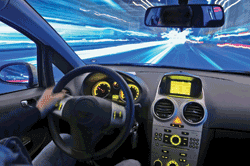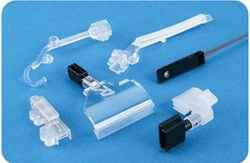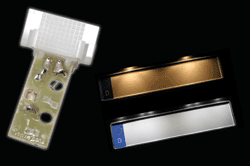New approaches for automotive interior lighting
With buyers’ expectations changing, care needs to be taken in selecting LEDs and light guides
BY MARK THORSELL
Elma Electronic, Fremont, CA
http://www.elma.com
If you are fortunate enough to own or to have test-driven some of today’s European luxury automobiles, you may have noticed what is now called “comfort lighting” in the vehicle. A departure from what used to just be called interior lighting, it involves illuminating the “people space” with mood-setting colors and intensity from different in-vehicle locations, such as from footwells or consoles. Comfort lighting can be beautiful and provide a soothing ambiance for vehicle occupants. It may be in addition to conventional interior lighting, or completely replace the “dome light” approach.

LEDs with light guides are used singularly or severally in today’s auto-lighting applications. They can be integrated into door handle areas, a keyhole light, or a turn blinker on an exterior mirror, or used as kick-panel lighting, cup-holder illuminators, and more. The shapes of light guides can be very simple (direct-light coupling) or more complex (see Fig. 1 ).

Fig. 1. LED and light guides for automotive lighting come in a variety of shapes and types to meet the exact illumination needs.
You would be amazed at how the light can seemingly be bent around a 90 or 180 angle, and still have enough output to perfectly envelop a door handle area with the precise brightness and coverage. The possibilities are almost endless and are only limited by the design, style, and functionality concepts of the interior design team.
A recent market survey shows that nearly all auto manufacturers in Europe, Asia, and the U.S. were planning to use some form of nontraditional lighting or indicating system in their new models, depending on luxury package options. However, these light systems have important design considerations, including light containment, wavelength quality and consistency, and testing.
Containment
One of the primary design considerations for these systems is the proper containment of the light within the lightpipe, which should limit light loss in reaching its intended target. Once the light exits the lightpipe, it has to stay in its intended area and go no further.
Both of these design requirements can be achieved by properly treating the inside surfaces of the lightpipe (containment), and by controlling how the light exits the lightpipe by properly shaping the diffusing or collimating surface of the light exit point. Because an LED’s radiating surface is a mere fraction of a standard incandescent lamp, any amount of light loss can be the tipping point from “successful design” to “unusable prototype.”
Light can be generated from a SMT LED device mounted on a miniature pc board, complete with current-limiting resistor and reverse-polarity protection diode (see Fig. 2 ). The emitted light is launched directly into (coupled to) a simple or elaborate lightpipe, which is an extremely primitive form of an optical waveguide. There is usually some form of properly fashioned “lens” or light exit surface, and the assembly is often mounted into the car interior by clipping it into a specific opening left in the door panel, center console, or dash board.

Fig. 2. The inside of a light system with the housing removed, showing the surface- mount LED device, current limiting resistor, and reverse- polarity protection diode. Light pipes can direct light in various ways, including the spotted approach in the top license plate and the light curtain effect in the bottom one.
Proper internal surface treatment and modern molding techniques make it possible for the light to be efficiently captured by the lightpipe, limiting losses and internally reflecting the photons down a given length and shape of light guide. Previously, some comfort lighting designs that would have required direct, incandescent lighting were not practical from a cosmetic standpoint, so they never made it into production.
LEDs and lightpipes, on the other hand, allow for more possibilities in smaller spaces with an average of 70% less size, heat, current requirements, total weight, and cost required over similar incandescents.
While comfort lighting systems are designed to illuminate something specific or contain light into one area, they can also create effects ranging from projecting the manufacturer’s brand logo on the car roof to emulating the effects of a thin curtain for illumination of a larger, shallow area. Figure 2 also shows two concepts of an illuminated license plate.
One example depicts two independent, unguided light sources that do not fully cover the license plate, leaving dark areas. The other shows a light curtain created with a lightpipe system that more evenly distributes the light across the license plate.
The light-curtain approach creates better lighting results with less current required, smaller wires to be run, more consistency of color and illumination and no bulbs to ever be replaced.
Quality, design consistency
In another departure from incandescent lighting, all conceptual designs for comfort lighting are proven before they are even prototyped using light spectrum analysis and propagation simulation software. All LEDs, regardless of their stated output color, contain a broader range of light components in the visible light spectrum (see Fig. 3 ). The software, which shows literally and graphically what colors are truly emitted, is used for development of all levels of comfort lighting systems in European vehicles.

Fig. 3. Simulation software is used to show the exact light spectrum for an LED, as well as the direction of the photons emitted (inset).
Designers should bear in mind that auto manufacturers want color consistency from vehicle to vehicle, so they must have consistency from lighting assembly to lighting assembly. Routinely, auto manufacturers will request a specific wavelength or “color coordinate” for the LEDs used in comfort lighting systems for their brand of vehicle. It must be consistent with all vehicles produced by this manufacturer year after year.
The color that an LED emits depends on materials used in the semiconductor junction of the diode. To generate specific colors, the materials are doped with arsenic, gallium, and other compounds.
LEDs from leading suppliers are graded or grouped into more or less uniform color batches. As the grouping increases in grade, the more closely matched the colors are guaranteed to be. Designers need to make sure their vendor’s color-grading scheme meets their tolerance requirements and specifications. When the auto manufacturer specifies a wavelength or color coordinate for their LED, interior lighting color will be consistent from car to car just as the vehicle’s outside paint color is consistent.
Reliability and testing
Imagine the stresses that LEDs can face inside an auto interior. It can heat up to over 200F or get down as low as the coldest temperature outside. And while LEDs themselves are not too susceptible to damage from vibration, shock, or moisture, their associated PCBs, connectors, and light guides are, and can fail due to a variety of other factors in the field as well.
One design consideration is that light guides in particular are subject to cracking, discoloration, and fading if good manufacturing processes have not been followed. The material in cheaply produced light guides can start to turn yellow over time when exposed to heat, so high-quality heat-resistant materials are a primary consideration for optical and physical reliability of light guides. High-grade polycarbonates are ideal for these applications; and with modern, extreme high-pressure injection-molding techniques, polycarbonate lightpipes will remain more optically transparent over time than other materials.
Designers should consider that during an after-market repair to a vehicle, it is possible to inadvertently apply reversed-polarity voltage to the comfort-lighting system. Hopefully, connectors with keying are used and replaced to factory recommendations if any repair is required. But if these connectors are replaced incorrectly and reverse voltage is applied, damage to the comfort lighting assembly is possible.
To protect the LEDs, a reverse-polarity protection diode should always be used along with the required current limiting resistor. While eliminating this step to help reduce cost — by a mere $0.005! is a common practice, it is also false economy.
A properly designed, manufactured, and installed comfort lighting system is a science unto itself. Entire companies are devoted to complete car interior designs, where experts work with suppliers of seats, lighting systems, sound systems, and ergonomic data to create a driving experience unlike any other.
Comfort lighting is a specialty that is only now beginning to show its effectiveness in luring car and truck buyers to seek extra pleasure from their driving experience. In terms of creating a mood, it has the same potential as a good sound system does for enticing a buyer to select one particular brand of vehicle over another.
A creative design, solid model validation, and complete system testing are just as important for comfort lighting using LEDs and light guides as they are for any other system in the vehicle. Employing proper design considerations for the light system is the helpful way to add value for the car buyer and encourage customer loyalty to any car brand. ■
Advertisement
Learn more about Elma Electronic





